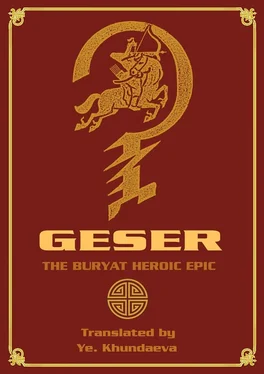Ye. Khundaeva - Geser. The Вuryat heroic epic
Здесь есть возможность читать онлайн «Ye. Khundaeva - Geser. The Вuryat heroic epic» — ознакомительный отрывок электронной книги совершенно бесплатно, а после прочтения отрывка купить полную версию. В некоторых случаях можно слушать аудио, скачать через торрент в формате fb2 и присутствует краткое содержание. ISBN: , Жанр: Языкознание, foreign_language, на английском языке. Описание произведения, (предисловие) а так же отзывы посетителей доступны на портале библиотеки ЛибКат.
- Название:Geser. The Вuryat heroic epic
- Автор:
- Жанр:
- Год:неизвестен
- ISBN:9785448558627
- Рейтинг книги:3 / 5. Голосов: 1
-
Избранное:Добавить в избранное
- Отзывы:
-
Ваша оценка:
- 60
- 1
- 2
- 3
- 4
- 5
Geser. The Вuryat heroic epic: краткое содержание, описание и аннотация
Предлагаем к чтению аннотацию, описание, краткое содержание или предисловие (зависит от того, что написал сам автор книги «Geser. The Вuryat heroic epic»). Если вы не нашли необходимую информацию о книге — напишите в комментариях, мы постараемся отыскать её.
Geser. The Вuryat heroic epic — читать онлайн ознакомительный отрывок
Ниже представлен текст книги, разбитый по страницам. Система сохранения места последней прочитанной страницы, позволяет с удобством читать онлайн бесплатно книгу «Geser. The Вuryat heroic epic», без необходимости каждый раз заново искать на чём Вы остановились. Поставьте закладку, и сможете в любой момент перейти на страницу, на которой закончили чтение.
Интервал:
Закладка:
It helps to comfortably visualize something because it observes the laws of nature and psychology, physiology of the human perception. Everything in nature obeys that law: the eye-sight, the pulse of the heart, the brain biorhythm, etc. It is also observed in structuring of poems, music and painting, as we have already noted.
Roughly speaking, the relation 2 to 3, 4 to 6, 6 to 10 is best. For instance, the sculpture looks best if the pedestal is 3 parts and the figure is 2 parts. Fibonacci made up a series of the natural numbers which proved to be of great use. This is as follows: 1, 1, 2, 3, 5, 8, 13, 21, etc. The law of the formation of the terms of this series is quite simple: the first two members are 1, then each subsequent member is formed by adding up of the two preceding terms. For example: 2 = 1 +1; 3 = 1 +2; 5 = 2 +3; 8 = 3 +5, etc. The Fibonacci series is known not only to mathematicians but to naturalists and other specialists too.
It was not until the 90-s of the XX century that the principle of the golden section was first mentioned in the academic works of the Buryat Geser experts. The Buryat tales are noted for the specific structural build-up, the image-bearing units, but the Buryat scholars did not associate that symmetry with the principle of the golden section. It was discovered by a Buryat scholar S. Sh. Chagdurov. He devoted one of his books to the phenomenon of the Altan Kheblic which is a Buryat analogue of the golden section.
A comprehensive study of the role of this phenomenon in the Buryat uliger (epic) was carried out by D. B. Badmatsyrenova [2001]. The thesis is called “The principle of the golden section in the Buryat epic “Geser”. The “Altan kheblig” means the golden model. The “Geser” epic observes the laws of the poetical structuring, one of which is the principle discussed.
The “Altan kheblig” was first mentioned in the Buryat epic by Pyokhon Petrov, one of the best Buryat epic-tellers of the XX century. The principle appears when the uliger episodes are in dynamics, when there is the gradual growth, then the highest point, the culmination and, last of all, the fall or the end. This dynamic symmetry was studied in the various epics – uligers written down from well-known Buryat epic-tellers.
The academic collection of the musical folklore started in the 60-s of the XXth century by D. S. Dugarov. The uliger tunes are very old, they present kind of a melodious recitative. The uligers did not have a certain fixed melody. Each rhapsode possessed one or more tunes and used it when performing all the uligers (stories, epics) that he knew. The peculiarity of the Buryat folk music is pentatonism. The melody or tune is depended on the structure of the verse. The verse and the tune closely interacted. S. Sh. Chagdurov and D. B. Badmatsyrenova noted that the golden section point is usually in the third quarter of a musical phrase.
The golden section is marked in the compositional lay-out of the uliger (epic) and gives prominence to the culminating points which are found not in the center of the epical text but in its third quarter. The most important function of the golden section in the text is semantical, notional, dynamical, structuring and euphonic. It is the symmetry of the laws of motion and growth in nature.
Due to the principle of the Altan kheblig presented in the main constructive units of the epic of Geser the listeners could not but feel them. The rhapsodes and the listeners could not but get adjusted to the betta-wave which dominated and caused the feeling of joy and success. In the rhythmical build-up of the verse in “Geser” an asymmetric division into the syllables is observed, when in the first hemistich there are 5 syllables, in the second 3 syllables. The interrelationship of 5 to 3 is 1.66 which almost ideally corresponds to the proportion of the golden section.
In the scene of the struggle between Abai Geser and Orgoli tiger the beginning and the intensification of the action (384 lines) is one and a half times as longer as the culmination and the concluding lines (строка) (223 lines). The interrelation of the numbers 384 to 223 makes approximately 1.7 which is close to the mathematical expression of the golden section equaling 1.618. On the whole there are 607 lines in this scene which is one and a half times as longer as the number of the lines in the intensified action (384 lines). The relation of the two numbers, i.e. 607 and 384 is close to 1.6.
One can state that the principle of the golden section is traced in architecture, painting, poetry, music, as well as mathematics and the other areas of the natural and human activity. The principle of the Altan keblig, an original analogue of the golden section, is well presented in the text of the Geser epic which was called “the greatest epic of the humanity” by a well-known Russian poet and translator Vladimir Soloukhin. The shamans and narrators or story-tellers have good memory, artistry and expressiveness of speech. Owing to the gifted story-tellers and shamans, the skill for the masterly performance of the ancient pieces of poetry and prose remains well preserved up to now.
The religious cults and rituals
The ideas of the heavenly origin of the totemic forefathers of the Buryats as well as the ideas of the spirit-hosts of the localities, the shamans, the epical heroes are related to the archaic cult of the Eternal Blue Sky which is taken to be the highest divinity and the creator of all that is found in the Universe. The highest divinity, the Sky or the Heaven (tengri in Buryat) is personified in the epic as Khormusta Tengeri or Esege Malan Tengeri. The most archaic cult of the Mother-Earth, the foremother, has the genetic ties with the cult of the World Tree and the World Mountain. It has greatly affected the emergence of the other, not less popular cults, like those of the fire, the mountain caves, the water (rivers, lakes), the genealogical tree. When reading the epic one comes across the other cults, like those of the ancestors, the magic. There are the shamanic elements and the Buddhist inclusions. Then one can mention the cosmogonic prologue of the epic, the creation of the main hero by the Heavenly Gods who was then sent down to the Earth with the mission of fighting the evil, Geser’s three celestial sisters, the theme of the cosmic marriage or the motive of being born from a cracked-apart stone. The archetype of the celestial forefather is often connected with the solar motive, e.g. a golden pole or the rays of the Sun coming through the upper opening of the yurt are associated with the conception of the son.
The proto-Buryats, i.e. the hunters and gatherers or pickers of the plants including the sorrel, garlic, berries, kind of bulbil lily representing the forest tribe communities entered the new stage of the social and economic life brought about by the establishment of the paternal right much later than the ancestors of the other nomad tribes. The socio-economical ties were those of a tribal community and the Buryats did not undergo the process of unification for a considerable period of time. Even in the end of the XIX century the Buryats somewhat preserved the patriarchal and tribal relations since the new tendencies did not display themselves so vividly in their economy: there were neither factories, nor railroads, nor electricity, etc. Due to this the epic preserved itself in a pure form with some impacts of the feudal and Buddhist ideologies. One should mention that the epic of Geser in its versified version which is believed to be the Buryat creation was preserved by the “western” Buryats. Аmong them most widely spread were the shaman rites. One can say that the oral “Geser” and the shamanism are to some extent interrelated. The versification and the shaman elements evidence of “Geser’s” being old-aged since it is generally recognized that the most ancient epical works of the Mongolian people as well as the shaman invocations were in verse not in prose.
Читать дальшеИнтервал:
Закладка:
Похожие книги на «Geser. The Вuryat heroic epic»
Представляем Вашему вниманию похожие книги на «Geser. The Вuryat heroic epic» списком для выбора. Мы отобрали схожую по названию и смыслу литературу в надежде предоставить читателям больше вариантов отыскать новые, интересные, ещё непрочитанные произведения.
Обсуждение, отзывы о книге «Geser. The Вuryat heroic epic» и просто собственные мнения читателей. Оставьте ваши комментарии, напишите, что Вы думаете о произведении, его смысле или главных героях. Укажите что конкретно понравилось, а что нет, и почему Вы так считаете.











